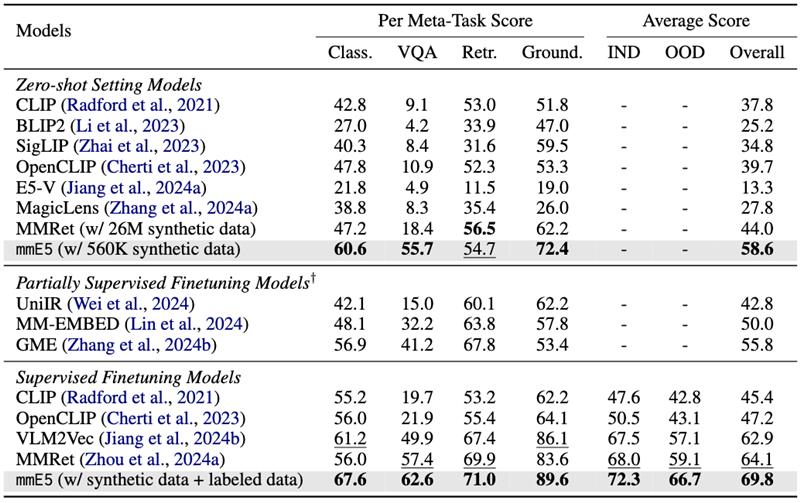Mme5 Mllama 11b Instruct
模型简介
该模型专注于多模态(图像+文本)和多语言嵌入任务,能够将图像和文本映射到统一的嵌入空间,支持跨模态检索和相似度计算。
模型特点
多模态嵌入能力
能够同时处理图像和文本输入,将它们映射到统一的嵌入空间
多语言支持
支持8种语言的文本处理,包括英语、中文、阿拉伯语等
高质量合成数据训练
使用专门设计的合成数据进行训练,提高模型性能
最先进性能
在MMEB基准测试中达到最先进水平
模型能力
图像-文本相似度计算
跨模态检索
多语言文本嵌入
零样本图像分类
使用案例
跨模态检索
图像搜索
通过文本查询检索相关图像
示例中'一只猫和一只狗'的查询与图像匹配度达0.4219
文本搜索
通过图像检索相关文本描述
示例中图像与'一只猫和一只狗'的文本匹配度达0.4414
多语言应用
多语言图像标注
为图像生成多语言描述或标签
🚀 mmE5-mllama-11b-instruct
mmE5-mllama-11b-instruct 模型基于高质量合成数据改进了多模态多语言嵌入,在多模态多语言评估基准(MMEB)上取得了优异的表现。该模型基于 Llama-3.2-11B-Vision 进行训练,为多模态多语言任务提供了强大的支持。
🚀 快速开始
模型信息
- 论文链接:mmE5: Improving Multimodal Multilingual Embeddings via High-quality Synthetic Data。作者包括 Haonan Chen、Liang Wang、Nan Yang 等,发表于 arXiv 2025。
- 基础模型:此模型基于 Llama-3.2-11B-Vision 进行训练。
- GitHub 仓库:Github
训练/评估数据
- 训练数据:
- https://huggingface.co/datasets/intfloat/mmE5-MMEB-hardneg
- https://huggingface.co/datasets/intfloat/mmE5-synthetic
- 评估数据:
- https://huggingface.co/datasets/TIGER-Lab/MMEB-eval
- https://huggingface.co/datasets/Haon-Chen/XTD-10
实验结果
本模型在 MMEB 基准测试中达到了当前最优性能(SOTA)。

💻 使用示例
基础用法
Transformers 库使用示例
以下示例改编自 VLM2Vec。
import torch
import requests
from PIL import Image
from transformers import MllamaForConditionalGeneration, AutoProcessor
# Pooling and Normalization
def last_pooling(last_hidden_state, attention_mask, normalize=True):
sequence_lengths = attention_mask.sum(dim=1) - 1
batch_size = last_hidden_state.shape[0]
reps = last_hidden_state[torch.arange(batch_size, device=last_hidden_state.device), sequence_lengths]
if normalize:
reps = torch.nn.functional.normalize(reps, p=2, dim=-1)
return reps
def compute_similarity(q_reps, p_reps):
return torch.matmul(q_reps, p_reps.transpose(0, 1))
model_name = "intfloat/mmE5-mllama-11b-instruct"
# Load Processor and Model
processor = AutoProcessor.from_pretrained(model_name)
model = MllamaForConditionalGeneration.from_pretrained(
model_name, torch_dtype=torch.bfloat16
).to("cuda")
model.eval()
# Image + Text -> Text
image = Image.open(requests.get('https://github.com/haon-chen/mmE5/blob/main/figures/example.jpg?raw=true', stream=True).raw)
inputs = processor(text='<|image|><|begin_of_text|>Represent the given image with the following question: What is in the image\n', images=[image], return_tensors="pt").to("cuda")
qry_output = last_pooling(model(**inputs, return_dict=True, output_hidden_states=True).hidden_states[-1], inputs['attention_mask'])
string = 'A cat and a dog'
text_inputs = processor(text=string, return_tensors="pt").to("cuda")
tgt_output = last_pooling(model(**text_inputs, return_dict=True, output_hidden_states=True).hidden_states[-1], text_inputs['attention_mask'])
print(string, '=', compute_similarity(qry_output, tgt_output))
## A cat and a dog = tensor([[0.4219]], device='cuda:0', dtype=torch.bfloat16)
string = 'A cat and a tiger'
text_inputs = processor(text=string, return_tensors="pt").to("cuda")
tgt_output = last_pooling(model(**text_inputs, return_dict=True, output_hidden_states=True).hidden_states[-1], text_inputs['attention_mask'])
print(string, '=', compute_similarity(qry_output, tgt_output))
## A cat and a tiger = tensor([[0.3184]], device='cuda:0', dtype=torch.bfloat16)
# Text -> Image
inputs = processor(text='Find me an everyday image that matches the given caption: A cat and a dog.\n', return_tensors="pt").to("cuda")
qry_output = last_pooling(model(**inputs, return_dict=True, output_hidden_states=True).hidden_states[-1], inputs['attention_mask'])
string = '<|image|><|begin_of_text|>Represent the given image.\n'
tgt_inputs = processor(text=string, images=[image], return_tensors="pt").to("cuda")
tgt_output = last_pooling(model(**tgt_inputs, return_dict=True, output_hidden_states=True).hidden_states[-1], tgt_inputs['attention_mask'])
print(string, '=', compute_similarity(qry_output, tgt_output))
## <|image|><|begin_of_text|>Represent the given image. = tensor([[0.4414]], device='cuda:0', dtype=torch.bfloat16)
inputs = processor(text='Find me an everyday image that matches the given caption: A cat and a tiger.\n', return_tensors="pt").to("cuda")
qry_output = last_pooling(model(**inputs, return_dict=True, output_hidden_states=True).hidden_states[-1], inputs['attention_mask'])
string = '<|image|><|begin_of_text|>Represent the given image.\n'
tgt_inputs = processor(text=string, images=[image], return_tensors="pt").to("cuda")
tgt_output = last_pooling(model(**tgt_inputs, return_dict=True, output_hidden_states=True).hidden_states[-1], tgt_inputs['attention_mask'])
print(string, '=', compute_similarity(qry_output, tgt_output))
## <|image|><|begin_of_text|>Represent the given image. = tensor([[0.3730]], device='cuda:0', dtype=torch.bfloat16)
Sentence Transformers 库使用示例
你也可以使用 Sentence Transformers 库,该库对大部分预处理和后处理操作进行了封装。
from sentence_transformers import SentenceTransformer
import requests
# Load the model
model = SentenceTransformer("intfloat/mmE5-mllama-11b-instruct", trust_remote_code=True)
# Download an example image of a cat and a dog
dog_cat_image_bytes = requests.get('https://github.com/haon-chen/mmE5/blob/main/figures/example.jpg?raw=true', stream=True).raw.read()
with open("cat_dog_example.jpg", "wb") as f:
f.write(dog_cat_image_bytes)
# Image + Text -> Text
image_embeddings = model.encode([{
"image": "cat_dog_example.jpg",
"text": "Represent the given image with the following question: What is in the image",
}])
text_embeddings = model.encode([
{"text": "A cat and a dog"},
{"text": "A cat and a tiger"},
])
similarity = model.similarity(image_embeddings, text_embeddings)
print(similarity)
# tensor([[0.3967, 0.3090]])
# ✅ The first text is most similar to the image
# Text -> Image
image_embeddings = model.encode([
{"image": dog_cat_image_bytes, "text": "Represent the given image."},
])
text_embeddings = model.encode([
{"text": "Find me an everyday image that matches the given caption: A cat and a dog."},
{"text": "Find me an everyday image that matches the given caption: A cat and a tiger."},
])
similarity = model.similarity(image_embeddings, text_embeddings)
print(similarity)
# tensor([[0.4250, 0.3896]])
# ✅ The first text is most similar to the image
📄 许可证
本项目采用 MIT 许可证。
📚 引用
如果你使用了本模型,请引用以下论文:
@article{chen2025mmE5,
title={mmE5: Improving Multimodal Multilingual Embeddings via High-quality Synthetic Data},
author={Chen, Haonan and Wang, Liang and Yang, Nan and Zhu, Yutao and Zhao, Ziliang and Wei, Furu and Dou, Zhicheng},
journal={arXiv preprint arXiv:2502.08468},
year={2025}
}
Codebert Base
CodeBERT是一个面向编程语言与自然语言的预训练模型,基于RoBERTa架构,支持代码搜索和代码生成文档等功能。
多模态融合
C
microsoft
1.6M
248
Llama 4 Scout 17B 16E Instruct
其他
Llama 4 Scout是Meta开发的多模态AI模型,采用混合专家架构,支持12种语言的文本和图像交互,具有17B激活参数和109B总参数。
多模态融合 Transformers 支持多种语言
Transformers 支持多种语言
 Transformers 支持多种语言
Transformers 支持多种语言L
meta-llama
817.62k
844
Unixcoder Base
Apache-2.0
UniXcoder是一个统一的多模态预训练模型,利用代码注释和抽象语法树等多模态数据预训练代码表示。
多模态融合 Transformers 英语
Transformers 英语
 Transformers 英语
Transformers 英语U
microsoft
347.45k
51
TITAN
TITAN是一个多模态全切片基础模型,通过视觉自监督学习和视觉-语言对齐进行预训练,用于病理学图像分析。
多模态融合 Safetensors 英语
Safetensors 英语
T
MahmoodLab
213.39k
37
Qwen2.5 Omni 7B
其他
Qwen2.5-Omni 是一个端到端的多模态模型,能够感知文本、图像、音频和视频等多种模态,并以流式方式生成文本和自然语音响应。
多模态融合 Transformers 英语
Transformers 英语
 Transformers 英语
Transformers 英语Q
Qwen
206.20k
1,522
Minicpm O 2 6
MiniCPM-o 2.6是一款手机端运行的GPT-4o级多模态大模型,支持视觉、语音与直播流处理
多模态融合 Transformers 其他
Transformers 其他
 Transformers 其他
Transformers 其他M
openbmb
178.38k
1,117
Llama 4 Scout 17B 16E Instruct
其他
Llama 4 Scout是Meta推出的17B参数/16专家混合的多模态AI模型,支持12种语言和图像理解,具有行业领先性能。
多模态融合 Transformers 支持多种语言
Transformers 支持多种语言
 Transformers 支持多种语言
Transformers 支持多种语言L
chutesai
173.52k
2
Qwen2.5 Omni 3B
其他
Qwen2.5-Omni是一款端到端多模态模型,能够感知文本、图像、音频和视频等多种模态信息,并以流式方式同步生成文本和自然语音响应。
多模态融合 Transformers 英语
Transformers 英语
 Transformers 英语
Transformers 英语Q
Qwen
48.07k
219
One Align
MIT
Q-Align是一个多任务视觉评估模型,专注于图像质量评估(IQA)、美学评估(IAA)和视频质量评估(VQA),在ICML2024上发表。
多模态融合 Transformers
Transformers
 Transformers
TransformersO
q-future
39.48k
25
Biomedvlp BioViL T
MIT
BioViL-T是一个专注于分析胸部X光片和放射学报告的视觉语言模型,通过时序多模态预训练提升性能。
多模态融合 Transformers 英语
Transformers 英语
 Transformers 英语
Transformers 英语B
microsoft
26.39k
35
精选推荐AI模型
Llama 3 Typhoon V1.5x 8b Instruct
专为泰语设计的80亿参数指令模型,性能媲美GPT-3.5-turbo,优化了应用场景、检索增强生成、受限生成和推理任务
大型语言模型 Transformers 支持多种语言
Transformers 支持多种语言
 Transformers 支持多种语言
Transformers 支持多种语言L
scb10x
3,269
16
Cadet Tiny
Openrail
Cadet-Tiny是一个基于SODA数据集训练的超小型对话模型,专为边缘设备推理设计,体积仅为Cosmo-3B模型的2%左右。
对话系统 Transformers 英语
Transformers 英语
 Transformers 英语
Transformers 英语C
ToddGoldfarb
2,691
6
Roberta Base Chinese Extractive Qa
基于RoBERTa架构的中文抽取式问答模型,适用于从给定文本中提取答案的任务。
问答系统 中文
R
uer
2,694
98